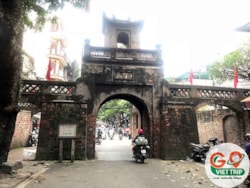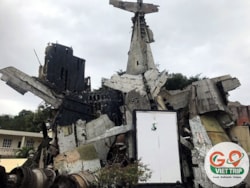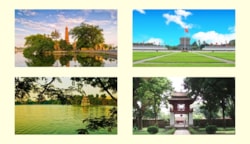1. Location and History
Dong Ho is a small village lying peacefully on the southern bank of the Duong River, about 35 kilometers to the East of Hanoi. More specifically, it is set within Song Ho commune, Thuan Thanh district, Bac Ninh province. Albeit widely known as ‘Dong Ho,’ its formal name is actually Mai village.
The beginning of Dong Ho paintings dates back as far as the 11th century under the Ly Dynasty, while some researchers claimed it was the Le Dynasty. At that time the villagers only made black-and-white prints of woodcuts. But as the craft gradually flourished, craftsmen began introducing different colors into the paintings, which remain until today.
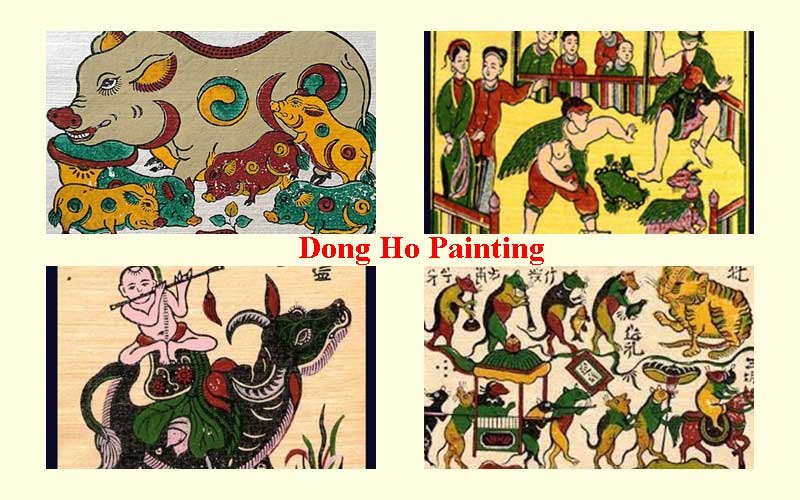
Popular painting still today
As a folk painting village, almost all villagers at Dong Ho were involved in making the paintings. Each was assigned a specific role in the process, including manufacturing the special ‘Diep’ papers, obtaining natural colors, carving the woodblocks, and printing.
Before 1945, over 150 families in Dong Ho earned a living by printing pictures. However, as modern Vietnamese culture gradually took shape, the tradition faded fast. Since demands for Dong Ho paintings significantly dropped, most craftsmen quitted their jobs.
At present, only two families of Nguyen Huu Sam and Nguyen Dang Che stick to the traditional craft.
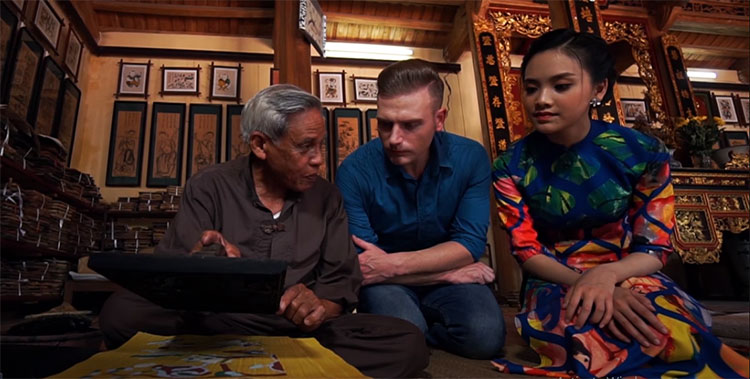
Artisan Nguyen Dang Che introduce visitors to how to make Dong Ho painting.
2. Where and How to make Dong Ho painting
The best place is to visit the village, you can experience it like a local artisan.
Dong Ho paintings are special due to their unique manufacturing process and materials.
This is a manual printing process, the finished picture is due to a combination of carving the woodblock and colors that have been arranged in sequence.
To make a single Dong Ho painting, the craftsmen first carve the woodblock into different shapes before applying paint and pressing it on a sheet of paper like a stamp.
Next to print painting - Dong Ho paintings are made on a special kind of "Diep" paper with beautiful color, to make "Diep" paper craftsmen need to take lots of time and effort. To be more specific, the bark of ‘do’ trees will be soaked in water for months before being mixed with powders of seashells and glutinous rice to produce sheets of paper.
The colors for the paintings are special too. They are not artificial colors but refined from many natural materials. For example, the black color is taken from burnt bamboo leaves, the green comes from cajuput leaves, and the blue is from copper rust.
Each color requires a different woodblock, and each layer of color is printed precisely without overlapping. Red comes first, then green, yellow, white, and black. Each day they can print one color.

Here are 5 steps to print colors
Then, the whole painting is coated with a layer of sticky rice paste before being dried under the sun for protection. Therefore, Dong Ho pictures can retain the original colors for a very long time.
>>> Read more food and tourist attractions in Hanoi
3. Why Are Dong Ho Paintings Special?
A single Dong Ho woodcut painting can take months to complete. In the past, craftsmen had to begin the process six or seven months ahead so that they could sell the paintings for the Tet holiday.
As it may suggest, one picture needs many woodblocks, and the blocks need to have matching designs to create a good painting. Therefore, woodblocks are a valuable asset to local craftsmen. Many families still keep ancient woodblocks until now.
4. The Meaning of Dong Ho Paintings
Although almost all craftsmen came from low-income families who could not afford exquisite artworks, Dong Ho pictures still had many themes and conveyed meaningful messages.
Dong Ho folk paintings mainly depict legendary characters, everyday life of the locals, countryside landscapes, and also wishes for prosperity. Some famous paintings include Jealous Fight (lampooning the polygamous system), Teacher (depicting old educational practice), Saint Giong (praising the legendary characters), etc.
Due to the colorful tones and optimistic themes, people usually bought paintings to decorate the houses during the Tet holiday with the belief in good luck. Dong Ho pictures were so popular that people even called them Tet paintings and spring paintings.
The best-selling paintings on the Tet holiday are ‘Herds of Pigs’ and ‘Flocks of Chickens’, which represent the wishes for happiness, prosperity, and success in the New Year.
Some Dong Ho pictures are famous for their humorous contents as well, particularly the ‘rat's wedding Dong Ho painting.’
Apart from single ones, Dong Ho paintings also come in couplets or quartets to fully express the message. For example, Vietnamese meaning Vinh Hoa ‘Eminence’ and Phu Quy ‘Prosperity and Honor’ should go side by side.
5. Some popular Dong Ho painting
5.1. Eminence, Prosperity and Honor (Vietnamese Vinh hoa phú quý)
These are two notable Dong Ho paintings because they must always go together in pairs to be fully meaningful. The pair of paintings "Vinh Hoa - Phu Quy" (Eminence, Prosperity, and Honor) has a deep meaning with the desire to congratulate and pray for the family to have a wealthy life.
It is often bought to hang in the house during Tet holidays in Vietnam.
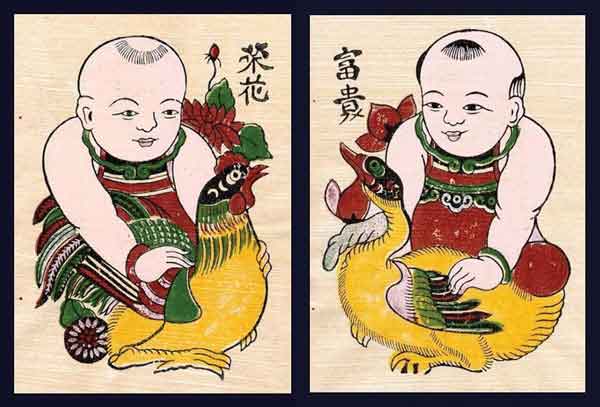
Vinh hoa phu quy
5.2. Rat's wedding Dong Ho painting (Vietnamese Đám cưới chuột)
"Rat Wedding" is perhaps the most special painting of Dong Ho painting village. The picture depicts embezzlement, accepting bribes like a cat busy receiving birds and fish but forgetting its main task is to catch mice.
Because of its special meaning, "Rat Wedding" is often bought to hang at the office, in the house as a warning, reminder, and teaching those in authority to live righteously.
Therefore, the painting "Rat Wedding" always has a deep meaning.

Humorous rat wedding in painting
5.3. Herd of yin and yang pigs (Vietnamese Đàn lợn âm dương)
The image of a pig in Dong Ho folk painting is probably one of the best-shaped pigs. Because Dong Ho is a picturesque village in the middle of the countryside, a wonderful and loving view of a pet symbolized prosperity and abundance.
Pigs in Dong Ho paintings have a special meaning: Expressing affluence and prosperity and wishing for a prosperous new year.
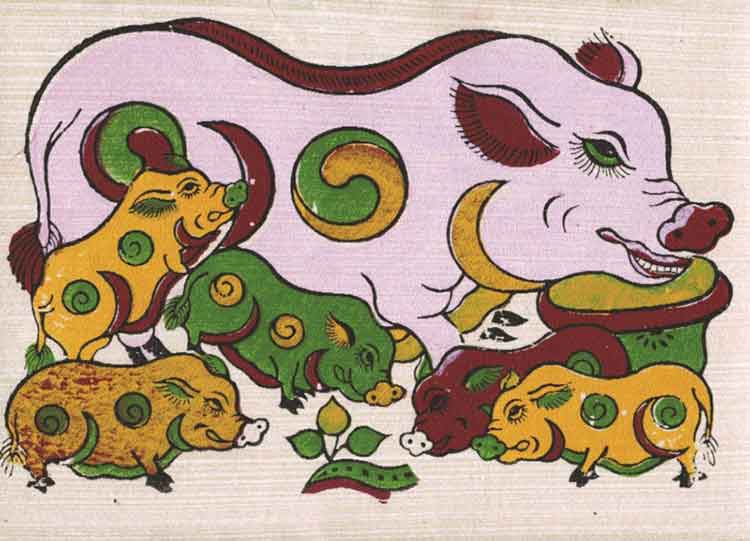
Herd of yin and yang pigs
5.4. Rose and Rooster (Vietnamese Gà trống hoa hồng)
"Rose and Rooster" is a picture of the abundance and crops, giving people a happy and prosperous life. These are considered simple and practical wishes that everyone wants, so people often hang this picture to decorate their home.

Vietnamese calling Gà trống hoa hồng
5.5. Feed buffalo and play the flute ((Vietnamese Chăn trâu thổi sáo)
Here is an interesting idea: A lotus leaf stands upright like an umbrella; The buffalo is craning its neck to enjoy the sound of the flute. Its posture and appearance make us seem to hear the musical sound of the flute in the clear and blue sky. A very peaceful and quiet life.

It looks very peaceful
6. How To Get To Dong Ho Painting Village
It is really easy to visit Dong Ho Painting Village if you are staying in Hanoi.
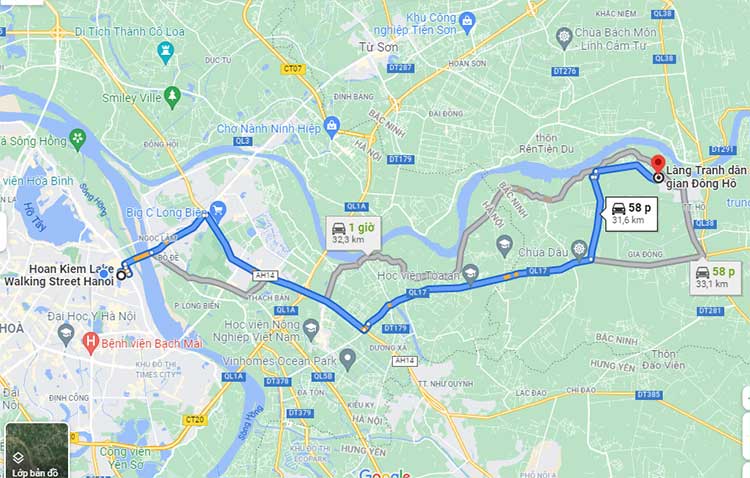
It takes an hour to get there from Hanoi city
Just go down National Highway 5 for about 15 kilometers for motorbikes and car drivers. Turn left at Phu Thuy Station, then keep driving for 18 kilometers until you reach Thuan Thanh district. Go all the way to Ho street and turn left at the second dike wharf. There you will find a signpost to Dong Ho folk painting village.
If you do not have any means of transportation, no problem! You can always take the 204 bus from Long Bien to Thuan Thanh district. Call a taxi or take a ‘xe om’ (motorbike taxi) to the village when you get off the bus.
Many Hanoi tours offer day trips to here and many other attractions in Thuan Thanh district, such as Dau Pagoda and But Thap Pagoda. You should double-check with your agent before booking a tour.
Tourists coming to Dong Ho Painting Village have a chance to marvel at beautiful paintings and learn about a unique traditional Vietnamese folk art. If you take a Hanoi tour, do not miss out on this great folk painting village.
If you plan to book a tour, or need any help please feel free to contact Go Viet Trip via email: Goviettrip@gmail.com or hotline +84968667589. We are guarantee about quality and prices. Get a full refund if you do not feel happy with our services.
Author Hoan Nguyen
He has over 10 years of experience working in the tourism sector and operator. He has traveled to many places in Vietnam and around the world.
Photos: Go Viet Trip, Internet

